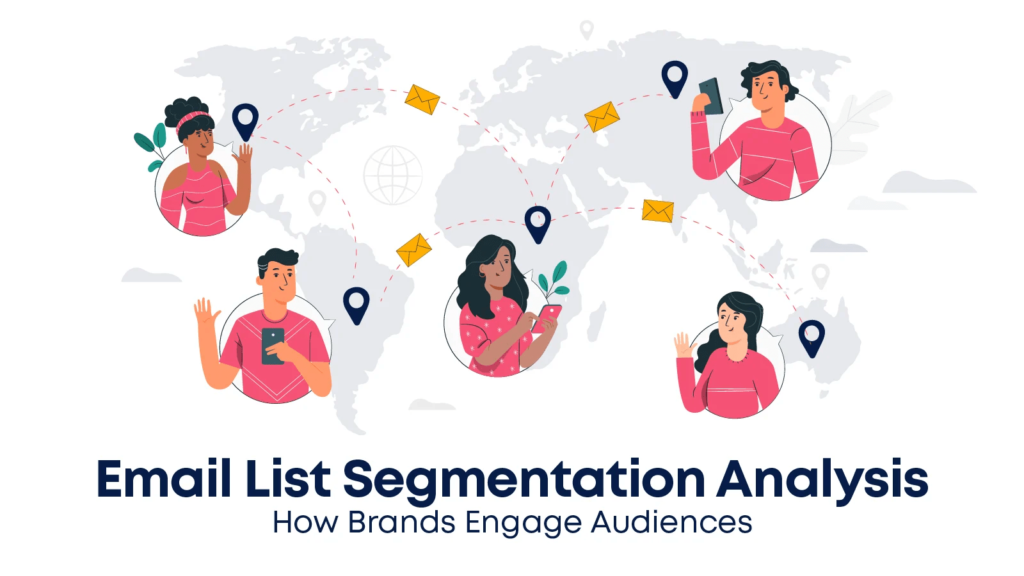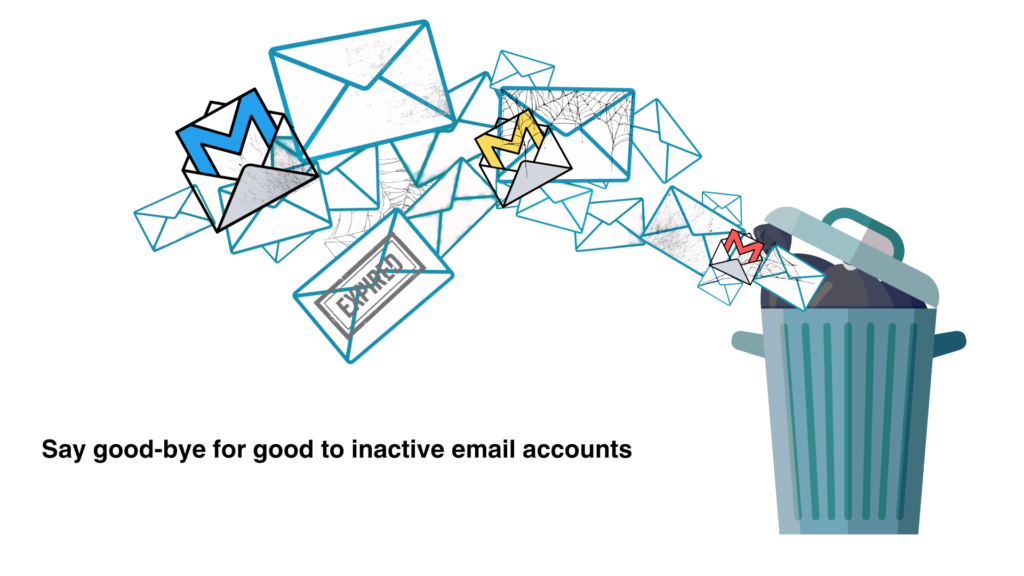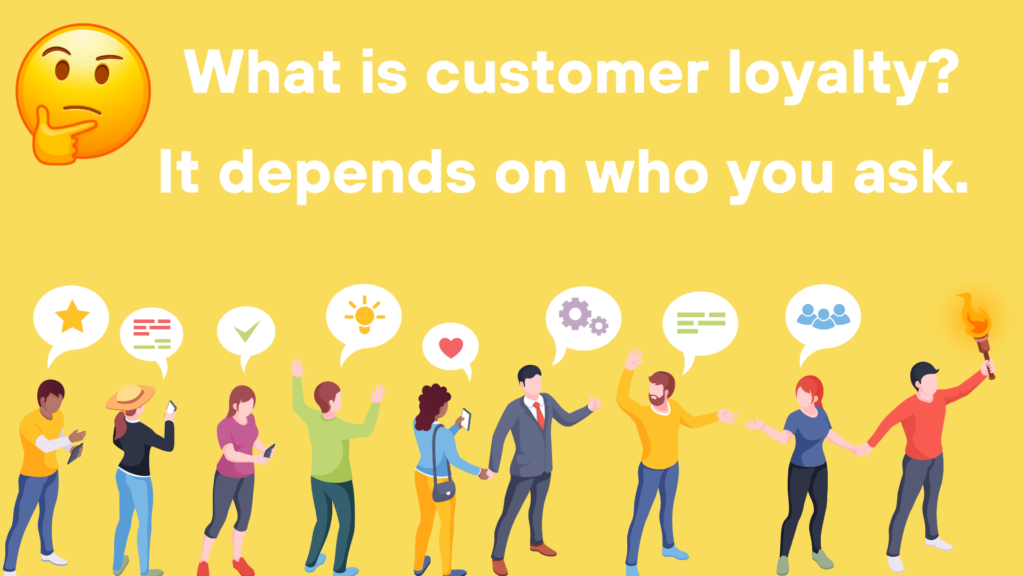If you want to create relationships, improve engagement rates, and ultimately your revenue, you must utilize email list segmentation. In this guide, we’ll take you through different ways to segment your email list, and show you exactly where and how to get the data you need to achieve this.
If you’re into email marketing, you know that without proper email list segmentation, your message will not arrive to the right recipients, especially when you’re sending millions of emails.
To illustrate how important email list segmentation is, imagine the following scene:
You’re standing at one end of an enormous football field with a megaphone. Spread out in front of you are hundreds and hundreds of people – all milling about, doing their own thing, chattering to one another, and enjoying their day.
You have a message to deliver and you raise the megaphone to your lips and start yelling at the crowd.
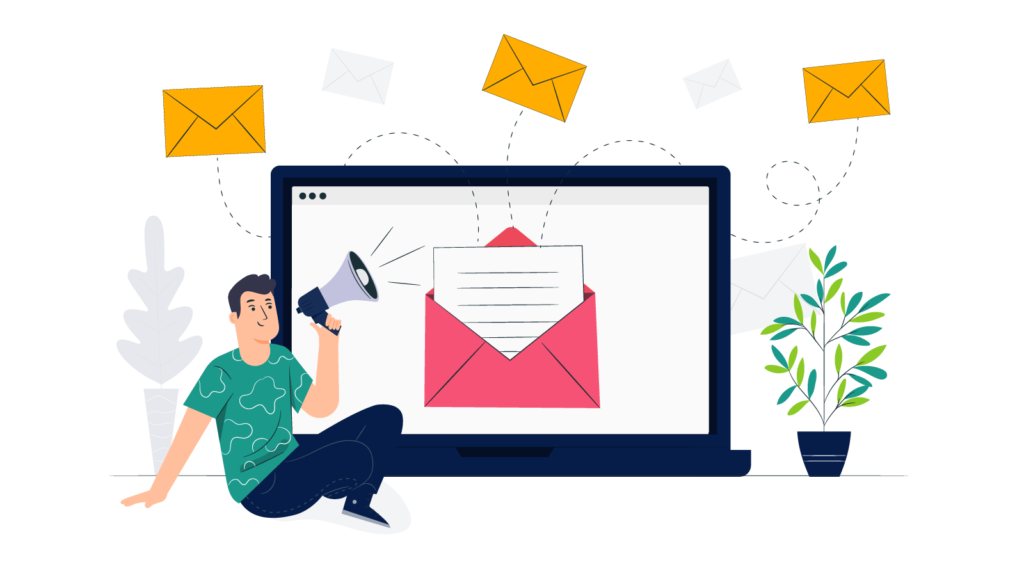
You invested a lot of time and effort to perfect this message. It’s a good one and you deliver it beautifully.
But does it get through to the crowd? Probably not.
In most cases, it will come off as noise, and here’s why:
You have two scenarios:
Best case – the people that heard you.
They are within your range, and your message is relevant or not relevant to them.
All the other cases are worst-case scenarios.
They can’t hear you properly over the general noise. They are either too busy or they’re not interested in your message because it’s irrelevant, so they ignore you and carry on with their lives.
Many are totally bewildered by the whole scenario, and there’s a good reason why – we have limited attention to spare, and we focus on what matters to us!
“Love all, trust a few, do wrong to none” – William Shakespeare
In this post, we’ll show you how to gain that trust, and build email list segments like brands who send billions of emails each month.

The complete
deliverability
handbook
Read the most significant, most organized volume of information written about email deliverability.
How audiences get engaged
If you whisper in someone’s ear, they’ll hear you. If you’ll talk to them face to face, they’ll listen.
Keeping this level of personal attention is hard, especially when there are additional participants in the conversations, noise pours in from all over, and the distance between you and the listener steadily increases.
That’s why getting personal, means also talking to a smaller, well-chosen audience.
It’s impossible to personalize a high-volume mailshot. Generic email blasts sent out to large volumes of people will always be met with some disinterest.
That disinterest will not only damage your brand/customer relations, it will lower your sender reputation.
Smaller segmented groups is the key to engaging your customers.

via email
By signing up you are agreeing to our Terms of Service
Your data will be handled in accordance with our Privacy Policy
What is email list segmentation?
Email list segmentation involves dividing users into groups based on shared data points. These data points can be broadly categorized according to four different criteria:
- Geographic – group audiences according to their location.
- Demographic – group audiences according to relevant demographic points (age, gender etc)
- Psychographic – group audiences according to shared beliefs, traits, values etc.
- Behavioral – group audiences according to their behavior (for example, are they highly engaged? What channel do they interact with most? And so on)
Each data point has its own value, and each can be obtained in different ways.

We segment emails, to keep them personal and our audience engaged. We do that to deliver the right message, to the right segment, at the right time.
With each data point, we get closer to knowing our target audience, and we start to understand what each individual on that list needs.
Let’s get back to that football field. This time you’ve selected a much smaller group to talk to.
They have something in common – they’re all aged 18-30.
This time, instead of shouting a general message to hundreds of folks, you can have a closer, more personal chat with these people about things which you know will interest and engage their age group.
Segmentation enables you to get to know your subscribers at a personal level, empowering you to send content that they will value and engage with, helping you to build relationships.
The Email Marketing Activity Book for Kids

How email list segmentation helps with your KPIs?
Companies that segment their email lists see significant improvements:
- Open rates go up by an average of 14.31%.
- Click rates enjoy a 54.79% increase.
- Email revenue is 760% higher.
But it gets better.
Tailoring your email marketing to smaller segments would mean better engagement and a better experience for your audience.
This improvement in your metrics signals to ISPs that you’re a good and reliable sender. This boosts your sender reputation, which in turn boosts email deliverability and grants your emails access to the coveted inbox.
What are some email list segmentation ideas?
Geography – heighten relevancy
Send a newsletter with actionable, geo-targeted information to your users. For example, if I’m located in Chicago, I don’t want a newsletter telling me all about fun stuff I can do in San Francisco.
Check out this great example from Ordnance Survey UK. Clicking through takes the user to a hyper-local map displaying all hiking routes, bike trails etc within walking distance of their own front door.
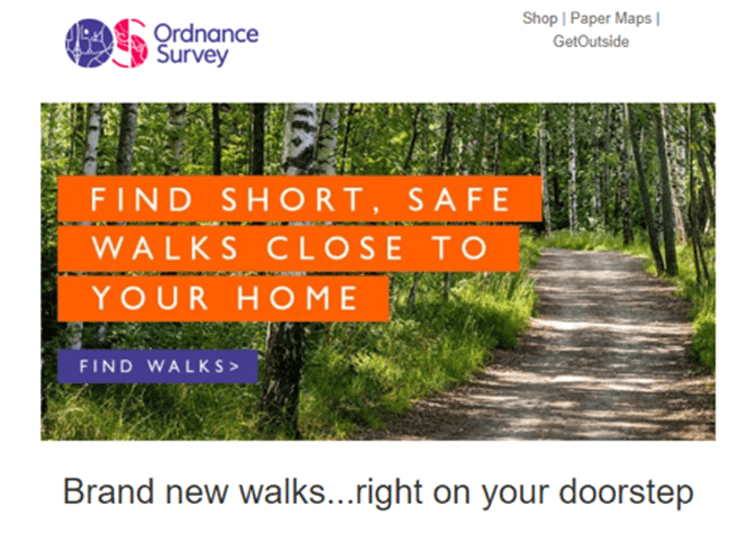
Send emails at appropriate times
There is no absolute ‘right time’ to send an email, but there are some best practices you should adopt to discover your ‘best time to send.’
Geographical time zones are a huge factor to consider. For example, 9am in London is 4am in Washington DC. If your audience is spread across time-zones, you should send your emails based on the timezone of your subscribers.
Think of the weather!
Getting your megaphone out in the pouring rain is pointless. Nobody will hear your message – they’ll be too busy running for shelter. It’s the same with email.
There’s a lot we could say about the weather and how it affects consumer behavior.
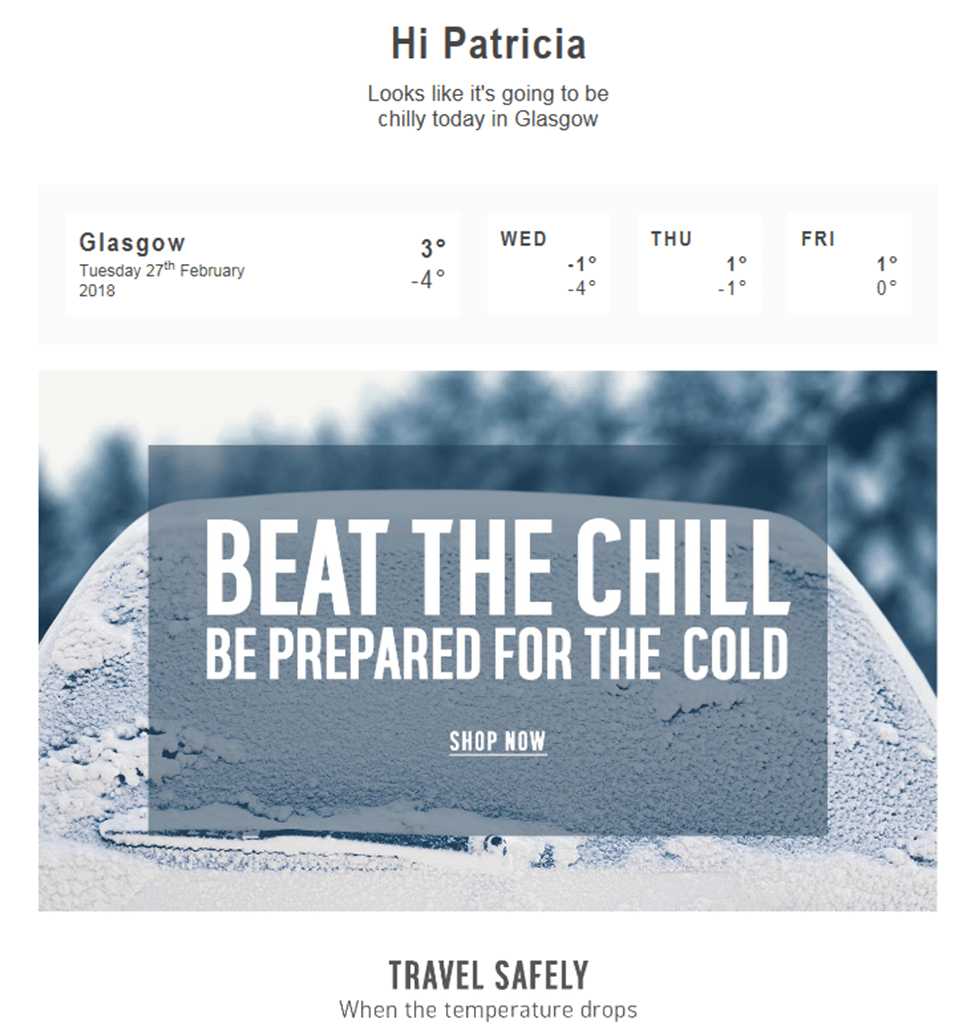
By weaving weather-appropriate theming and content into geo-targeted campaigns, you can add relevancy and value for your customers. Take this email from Argos as an example, the cold weather in the subscribers location, personalizes the content received.
Age – understand how age impacts the way your content is received
Age is not always a relevant consideration. However, for some products, it makes all the difference.
For example, younger age groups are more likely to be interested in high-octane workouts than older demographics.
Certain types of content and design will (broadly) be received differently by different age groups. ’Youthful’ slang and interactive content are good for younger, tech-savvy users, but older users may prefer simpler, more accessible language and design.
Maintain integrity
Be careful, though! It’s easy to come off as patronizing or ‘try-hard’ when you’re trying to market to specific generational cultures.
Let’s go back to that football field again. You’re talking to that group of 18-30-year-olds. But this time, let’s say you’re a straight-laced, suited individual in his 60s. You’re very obviously not ‘one of them’. Trying to use youth slang and gestures is going to come off horribly cringey.
Back in the late 90s, Mazda produced a minivan called the ‘Bongo Friendee’. It was supposed to be a ‘fun’, ‘hip’ name to appeal to the carefree youth culture of the time…
…but its target audience saw it for precisely what it was: a desperately undignified attempt by ‘the suits’ to tap into a culture they did not understand.
So, when personalizing on age-related grounds, remember to maintain your own integrity. Talk to your audience about issues relevant to them – but don’t try and actually be them if you’re not.
Significant dates – remember, this is a relationship
Brands and customers have a relationship with one another. And relationships are strengthened by acknowledging special dates, especially if that acknowledgment comes with a heartfelt gift (like an exclusive special offer).
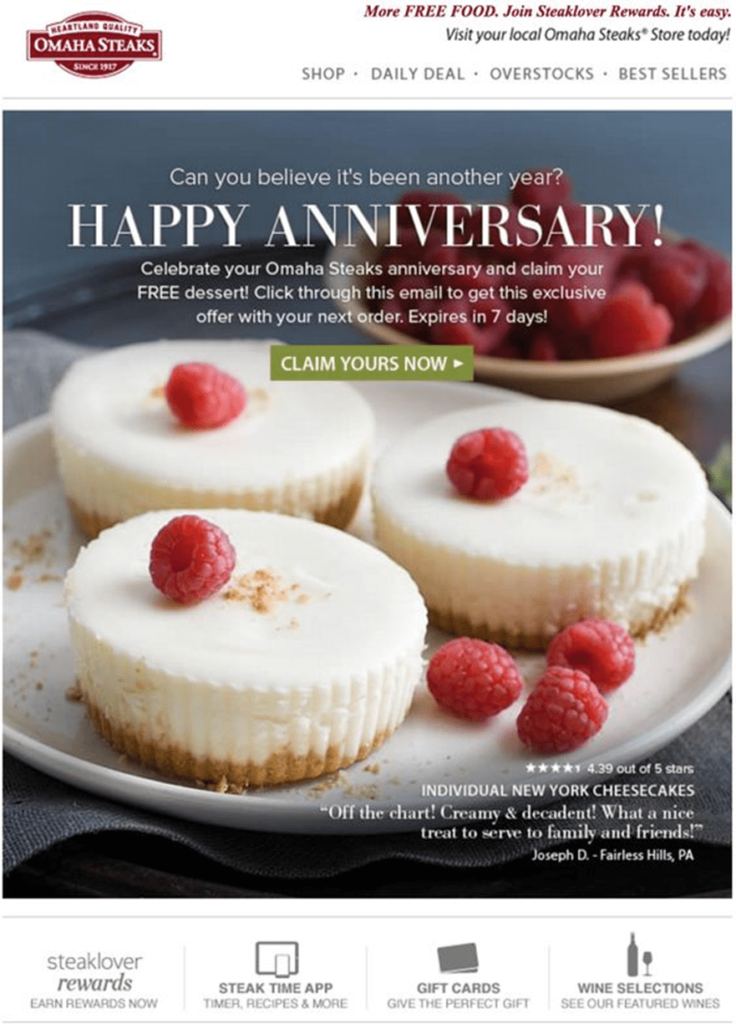
This example from Omaha Steaks celebrates an anniversary, and in doing so, they reward the happy couple with a free dessert.
Free vs. paid plans – tier your emails
If you offer both free and paid services, you’ll want to upgrade your free customers to paying customers. You’ll have a lot of content aimed at persuading free customers to take the leap and upgrade to paid.
Segment accordingly! Send ‘Upgrade now!’ emails to customers who are already paying, and you’re going to annoy them.
Purchasing habits – watch the data closely
It’s important to segment based on actual behavior. The shopping patterns of your users provide some of the most solid behavioral indicators you could hope for.
Did they buy a pillow? Then they’ll appreciate a complimentary pillowcase. Offer one!
Did they book a flight to London? Then they’ll find value in an email about hotels, car rentals, and entertainment in London.
Having said that, it’s possible to get carried away with this kind of thing. The insights you draw from purchasing behavior should be based on solid data patterns.
Everyone makes an out-of-character impulse purchase every once in a while, but nobody appreciates being hounded with emails offering similar items for weeks afterward.
Be cautious when picking a ‘complementary’ follow-up offer. Look at the rest of your data.
For example, if that customer booked a flight to London and is heading over there for a funeral, they won’t want an email about London’s most romantic dating spots.
Interest – track behavior
While purchasing data is good, it’s not the only tool available. You don’t have to wait until someone buys a product to gauge their interest in it.
Items viewed, emails clicked upon, pages visited – all of these indicate interest.
Use what you learn – but cautiously
You can leverage this interest in your email content. Ebay are masters at this kind of thing.
However, as with purchasing, it’s important not to get carried away. Make sure that this apparent interest really is part of a pattern and not just an accidental or whimsical one-time click.
Email List Segmentation Is Key

Segmentation according to Personas – create segments within segments
Take the data points you’ve established and use them to build personas for highly targeted emails.
Back to the football field. As you’re talking, you discover that middle-aged males turn their attention to you when you make sports references.
By building this ‘middle-aged male sports fan’ persona into a segment, you can intensively target this audience with sports references and get their full attention.

Consider lifetime values
If you get deep into persona-segmentation, you can deduct the lifetime values of certain groups. This will help you allocate your resources more effectively.
You may discover that subscribers of your email newsletter are more likely to be repeat purchasers than customers who are not. When comparing metrics with other channels, your email subscribers may have higher lifetime value than customers from other channels.
Segmentation according to engagement levels – opens and clicks
Don’t forget your email metrics
Segmentation based on email behavior is paramount.
- When was the last time a user opened your emails?
- How many times have they clicked in the last thirty days?
You can draw important, revenue-boosting insights from this data, such as how many times a subscriber has purchased a particular product and their average order value.
Don’t be shy – but don’t be too pushy
Different people at your football field speech will be comfortable with different levels of audience interaction. Some will love being called out personally. Others will run a mile if you so much as make eye contact.
There’s a sweet spot between ‘shy’ and ‘intrusive’ in any brand-subscriber relationship, but that spot is in a different place in each and every case.
Don’t shy away from sending emails, but do keep a close eye on your metrics to determine where to draw the line for each group.
Understand how this affects deliverability
Segmenting based on email behavior doesn’t just impact your engagement rate. It also impacts your deliverability.
Less engaged users will negatively affect your sender reputation. Send fewer or different emails, for instance, see this animated win-back email from Asana:
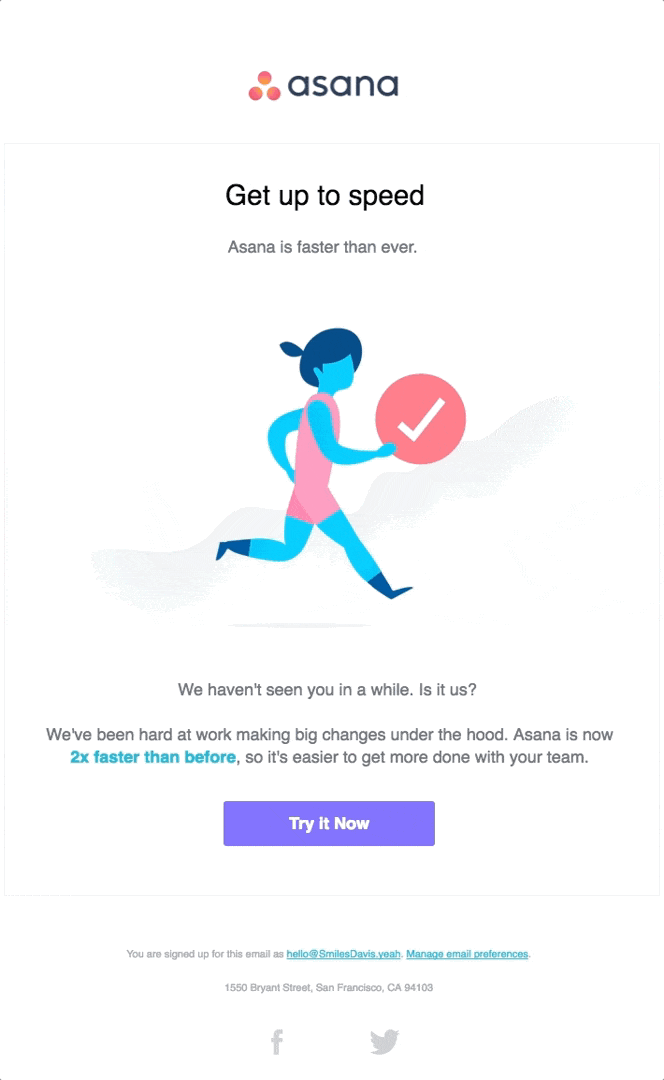
Or reduce the changes in performance when sending high-volumes of emails by segmenting sends to engaged groups.
On the football field, you’d do this through building an atmosphere that hypes up the really engaged people at the front, to detract from the disengaged folks milling about at the back. It’s a shift in focus.
Learn when to let go
Inactive users can become recycled spam traps in addition to lowering your engagement metrics.
Sending campaigns to segments including such addresses will result in bounced emails, harming your sender reputation.
Segmentation according to relevant data points
Coming up with segments can be fun. It’s a creative thing to do which draws on our instinctive understanding of our customers.
But beware! There has to be more substance to your segments than just great ideas. Each segment must be fixed to solid, measurable and actionable data points. Otherwise, it will be impossible to gain the insights you need to personalize your content.
It’s important not to treat segments like Pokemons. You don’t have to collect them all!
As with any marketing activity, set up your goals in advance and work your way through them, coming up with goal-appropriate segments along the way.
You don’t want to be investing resources in segments which aren’t relevant to either your goals or your operation.
Let’s say you’re using your football field speech to recruit for your minor league.
Is there any point in trying to engage, say, toddlers in your speech? No. That would be a waste of effort. (Toddlers are great and all, but they’re not going to get your team to the championships!)
Take some time to figure out which segments are actually relevant, and the data points you’ll need to target these segments.
Email behavior
There’s a lot of potential data in the newsletters you send. Opens and clicks (clicks more so) indicate interest from the user.
Advanced email marketing platforms like Ongage enable you to create data points based on the specific CTA a user clicked on. This opens the door for even deeper personalization.
An email can lead to a conversion on your website. This will provide even more data to work with – indicating your customer’s purchasing habits, updating their value, and more.
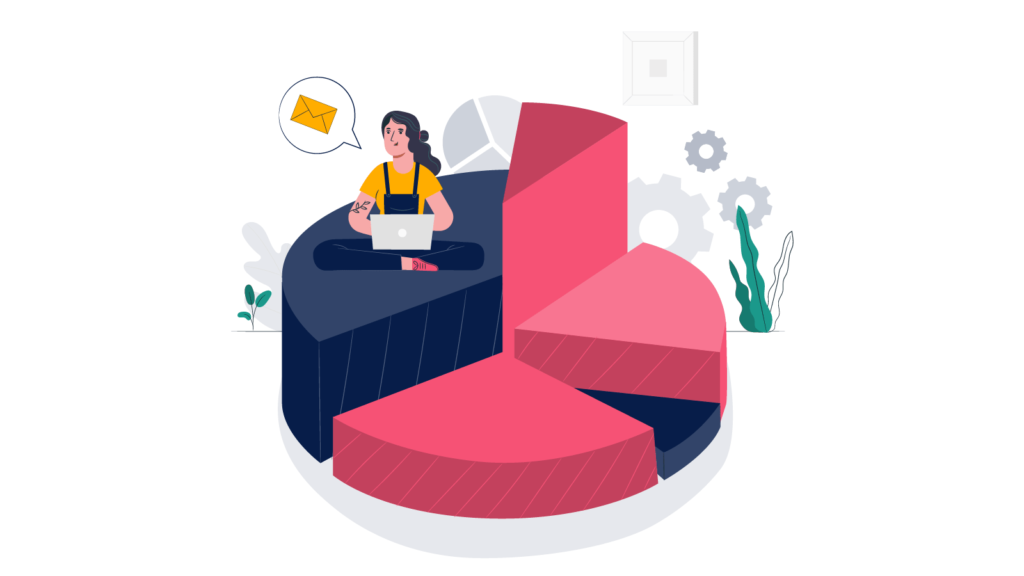
Preference center
While we encourage email marketing conversion optimization best practices, it’s often best to ask people outright what they want.
Set up a preference center so that your users can tell you about themselves. But make sure that it’s voluntary. Not everyone will want to share their age, country, and interests with you.
You can encourage people to share their preferences by highlighting the value it will bring for them. Promise engaging and relevant content. Also, don’t make the preferences too lengthy or tedious to pick.
Link to your preference center from your emails. Make the link obvious, and put it near the unsubscribe button. Addressing issues that they may have with your content in this way makes users less likely to unsubscribe.
Sign up forms
Sign-up forms are a fantastic opportunity to ask your users questions about themselves. At the point of sign up, they are actively interested and engaged with your product, they want to hear from you, and they are already prepared to give you some information.
But don’t ask for too much too soon.
Nobody likes a sign-up process which is more than a couple of clicks long. Having too many fields in your form can lead to form abandonment.
Test and experiment to find the right compromise between data-gathering and a smooth sign-up process.
Over time, you may find that it’s worthwhile in terms of revenue to have a smaller but more data-rich email list.
How to use welcome emails as a secondary data source?
If you don’t want to create too much friction during sign up, you can build a secondary data-gathering opportunity into your welcome email.
Customers nowadays will be expecting a welcome email – and are prepared to engage with it.
Open rates for welcome emails are among the highest of all. Put that engagement to good use by properly introducing yourself and inviting your users to introduce themselves in return.
Including a multichannel approach
One of the more promising ways to collect data is via your website.
By observing which pages your users visit and what they buy, you will quickly find yourself with heaps of information on your hands.
Sometimes, all of this data can be overwhelming. It’s important to circle back, focus on your goals, and to narrow your gathering down to just the data that you need.
You now know what you want to do, and you have some ideas on how to collect the data you need. The next step is putting all this to good use.
It’s time to send your segments some personalized emails.
Sending segmented emails
Integrating your data
Wherever you store your data points, be it CRMs or data warehouses, you have to have seamless CRM-email integration with your email campaigns.
Such an integration is key to opening the lines of communication between what the customer is telling you and your creative response, so you can send different types of transactional emails.
Once you’ve managed to integrate your data and your content operations, a world of endless segmentation and personalization possibilities reveals itself.
Set up segmented automation
Set up automated events based on particular data points (date of birth, for example, or cart abandonment).
To make full use of your set up, your email marketing platform should have an extensive email API integration. This allows you to send prompt, personalized, and often automated emails based on users’ website behavior.
Dynamic content feeds
You can take your segmentation to the next level with dynamic content feeds.
Once you’ve set your integrations, you’ll be able to send hyper-personalized emails from a single campaign, using only one line of code. This could include added dynamic HTML content feeds for each data point that you have collected to tailor the email’s content.
Combine this with automation rules, and you’ve got yourself a very efficient email operation.
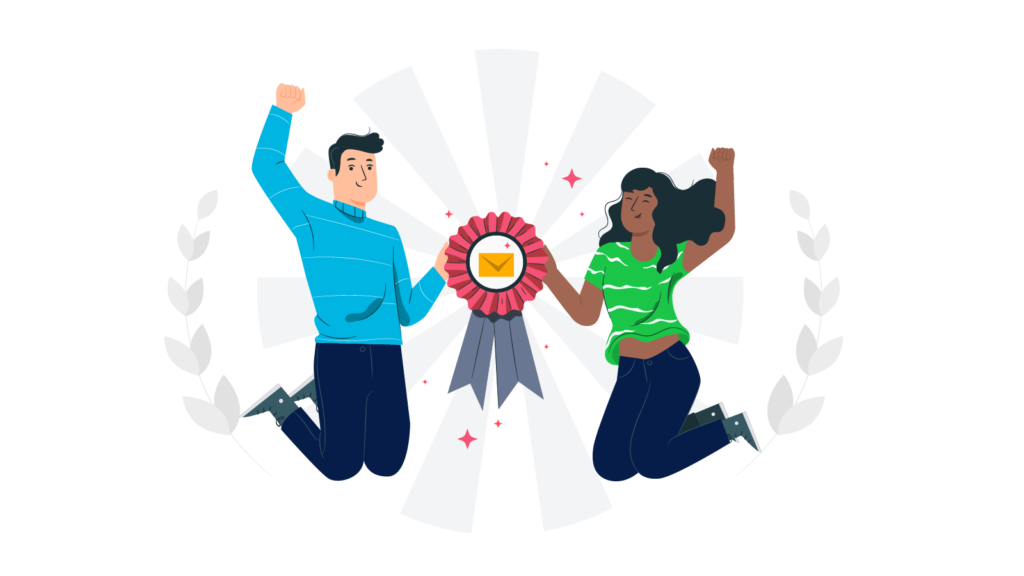
Email list segmentation is one of many steps
We all know that personalization is the key to effective marketing. And segmentation is just one of the many keys to achieving it.
Our email personalization guide is the best follow-up read for email marketers looking to take their email operation to the next level.

